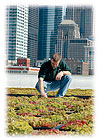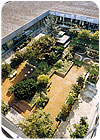
In the quest to find economically feasible green building alternatives, cutting-edge contemporary roofing technology is helping to bring garden roofs - a visually desirable architectural practice - into the mainstream. Savings from heating and cooling are one reason for the trend toward garden roofs, also known as green roofs, eco-roofs, living roofs and vegetative roofs.
Because of the additional green space, a garden roof can allow a developer to maximize the use of the property, which could greatly increase the property's value. Other savings comes from delaying water runoff from the building, which helps lower sewer and wastewater penalties. This benefit was witnessed firsthand by John Thomas, product development manager at Siplast Inc.
Thomas's company was responsible for providing the roofing and waterproofing membrane materials for the 10-acre Ford Motor Company garden roof - the largest living roof in the world - on the automaker's Dearborn Truck Plant. Noting the amount of money saved in cooling bills and avoiding the cost of modifying the River Rogue Treatment Plant, together with other potential pollution-related fines, Don Russell of Ford Motor Co. said, "The green roof had already paid for itself, and they hadn't even started producing cars yet."
Research from Dr. Karen Liu with the National Research Council of Canada (NRCC) shows that roof gardens have the potential to extend the life of the roofing material beyond its normal life span by shielding it from extreme weather, UV degradation, and temperature fluctuations that can cause damaging expansion and contraction of the membrane. David Roodvoets, technical director of the Single Ply Roofing Industry (SPRI), agrees. "There's minimal thermal stress, there's no water running over the membrane. We heard of a system in Europe that was built in 1938, and I was there in 2002 and it was still functioning."
If contractors want to further enhance the high thermal performance of single ply and multi-ply roofing membranes, roof gardens may indeed be one way to achieve this. Roof gardens lower the amount of heat absorbed by the building envelope through sunlight, and while traditional roofs can reach temperatures of 180°F, the transpiration process of the vegetation on a roof garden and the mass of the growing medium can keep a roof's temperature in the 70°F range.
This decrease in heat buildup translates into lower air conditioning bills and less initial outlay for air-conditioning systems, as smaller HVAC units can handle the reduced cooling requirements.

GREEN IN BOSTON The Seaport Hotel and Convention Center in Boston prominently features garden roofs.
Ecologically Sound and Environmentally Friendly
In addition to a possibility for an increase in property values and aesthetics, the ecological benefits of roof garden construction are manifold because they can dramatically reduce storm water runoff and flow rate, and depending on rain amount and garden depth, many rain events will result in no water draining off the roof. Overall, a garden roof can retain as much as 70 percent of rainfall, cutting down on the risk of flooding the building site.In Orlando, the University of Central Florida's Stormwater Management Academy has done extensive research into the flood-reduction aspect of roof gardens. Cities such as Washington D.C., Portland, Seattle and Chicago are already investing in green roofs as a crucial part of their storm water management programs.

WASTEWATER CONTROL Garden Roofs are not only visually desirable, they maximize the property's usable space and minimize wastewater runoff.
"The City of Chicago is probably the biggest market for roof gardens in the United States, and that's because the city has been very proactive, installing garden roofs on a lot of city buildings. The city provides incentives for privately operated commercial buildings that have installed roof gardens," said Dick Gillenwater, manager of advanced projects at Carlisle SynTec Inc. According to Jim Rubenacker, director of customer operations at Sarnafil Inc. "When the City of Chicago decided to have an intensive green roof installed on Chicago City Hall, it effectively put public awareness of such systems in place immediately. Tours of the rooftop educate the young and the not-so-young at the same time."
Additional research from NRCC centers on "evaportranspiration." Evapotranspiration occurs when plants secrete or "transpire" water through pores in their leaves much like the way people sweat. This cools the surrounding air by the evaporation of the water. This may help reduce the "heat island" effect common in cities or other large communities where energy usage is concentrated. In cities where pollution is an issue, studies show that the gardens may provide relief by capturing and filtering pollutants out of the air, and they can also help to neutralize acid rain.

Standards and Costs
If a building team decides on a garden roof to address sustainability issues, garden roofs may qualify for credits toward green building certification through the LEED Green Building Rating System, which was developed by the U.S. Green Building Council (USGBC). This national standard for green building certification awards credits in the category of Landscape & Exterior Design to Reduce Heat Island/Roof (Credit 7) for covering at least half of a roof with a garden, as well as regional green building standards set by such entities as the Florida Green Building Coalition.While the initial costs of garden roofs are higher in comparison to other cool roof systems for new construction and renovation projects, government incentives can offset initial outlays or increase the rate of return on initial investment. Green roof development in cities such as Portland, Ore., is being encouraged through development code incentives with such options as a Floor Area Ratio (FAR) that encourages green roof development for the purposes of water runoff control.
A FAR bonus allows the total area of a building to be larger than it might be permitted otherwise if certain criteria are met. For example, if the total area of the green roof is 10 percent to 30 percent of the building's footprint, each square foot of green roof earns one square foot of additional floor space. The amount of additional floor space then rises with a corresponding increase in size of the garden roof, with a garden roof covering from 30 percent to 60 percent of the building's roof earning two additional square feet, and roofs covering more than 60 percent of a building's roof gaining three feet of additional floor space.
Report Abusive Comment